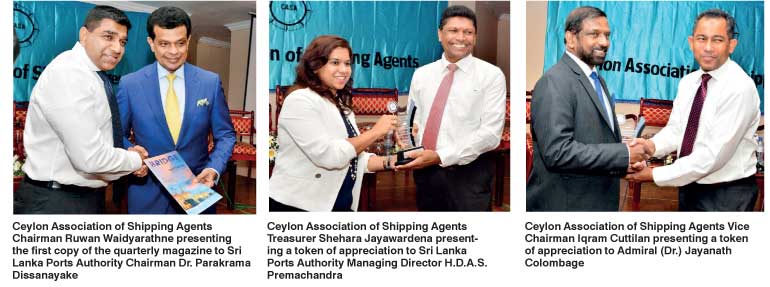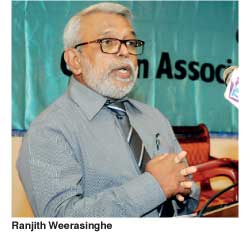He also stated that the Merchant Shipping Act and the Sri Lanka Ports Authority has not undergone changes with time, and sighted the importance of changing the role of SLPA to a more commercial entity. “SLPA cannot be the landlord, terminal operator and regulator at the same time,” he said. Bringing in an example from Singapore, he stated that the Port of Singapore Authority (PSA), formed in 1964, inaugurated the container berth, Tanjong Pagar, in 1972 and welcomed the first container ship in 1972. By 1988, PSA propelled Singapore to become the world’s busiest shipping port, the second-largest container port and the top bunkering port. In 1996, PSA was corporatized and remained as a terminal operator whilst transferring the entire regulatory function to the Maritime and Ports Authority of Singapore (MPA).In 1993, PSA International was launched, and today, operates 40 terminals in 16 countries.
Capt. Weerasinghe suggested bringing in a totally new parliamentary enactment to encompass entire shipping, maritime and logistics activities within a maritime development project which should be promoted, facilitated, and regulated by an apex body named Sri Lanka Maritime Authority.
The need for a single window instead of having so many different authorities and stages for approval was highlighted as a measure of easing the process of doing business, and the need for streamlining procedures was stressed, such as the elimination of different authorities boarding vessels as has been done in Singapore. The experts believed that this can be done through the formation of an independent maritime authority.

Branding and forming independent, un-politicised Maritime Promotion Bureau
Dr. Parakrama Dissanayake stated that we should brand ourselves as a maritime hub, and a single entity would be formed to promote the hub to the world. He stated that the Maritime Promotion Bureau should be un-politicised and represent the national policy of developing the industry. He also stated that we relate port management and container shipping with a maritime hub and as a result ignores other forms of shipping. He stated that 8,000 ships have been handled outside the Port of Galle and these are not container ships. Therefore, the Maritime Promotion Bureau will have the task of developing all sectors related to a Maritime Hub be it infrastructure, regulatory, ease of doing business etc.
Hambantota - would it play a special role?
Ray Ren and Jack Huang spoke extensively on the Port of Hambantota and how it can play a special role. With a current capacity of handling 198,000 TEUs and 950,000 tons of break bulk cargo, the port can also handle 396,000 units of Ro-Ro and 2.5 million tons of bulk cargo. In the first phase of development two 100,000-ton multi-purpose berths and one 100,000-ton oil berth is to be built followed by the second phase which will add two more 100,000-ton berths and two 10,000-ton berths. Phase 2 will also contain two 100,000-ton multipurpose berths and an oil berth of 100,000 tons.
The speakers highlighted the short transit times from Hambantota to both east and west destinations which gives the port the strategic location advantage. The proposed LNG power plant, LPG, cement, refinery and the dockyard are expected to be major developments in the future for Hambantota. As a hub, closest to the Indian Sub-Continent, Sri Lanka serves a vast hinterland of 7 countries in South Asia with more than 1.5 billion people. Sri Lanka has established a convenient feeder network between the Port of Colombo and other ports of India, Bangladesh and Pakistan. 90% of the transhipment cargo that is handled here are from India, Pakistan and Bangladesh, while currently the Port of Colombo is only handling 15% of total transhipment cargo for South Asia countries.
Conclusion
Most of the speakers highlighted the importance of quick actions as other countries in the region have developed immensely in the last few years. Establishing a single entity responsible for infrastructure development and regulatory changes was raised by all speakers, stating that we do not have the luxury of time. Changing regulations to suit current and future trends, developing ancillary services, building human capacity, and visionary leadership were points highlighted by all speakers. In his remarks, Dr. Parakrama Dissanayake stated that he has seen many ‘talk shop’, but it is now time to put them into action.


 Prevention of marine pollution and coastal management
Prevention of marine pollution and coastal management
